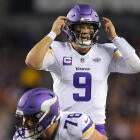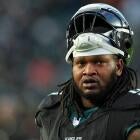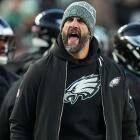
Five burning questions the Chiefs will have to answer during the 2020 offseason
If Kansas City wants to repeat as Super Bowl champion, it will have some work to do this offseason
The Kansas City Chiefs are your Super Bowl champions. We hope you enjoyed the ride, Chiefs fans, because the rest of the NFL has already moved on and began jockeying for position in the 2020 season Monday. The Chiefs, after they hold their Super Bowl parade later Wednesday, will begin that jockeying as well. With that race in mind, here are the biggest questions facing the Chiefs during the 2020 offseason.
1. How much will it cost to extend Patrick Mahomes?
The easy answer here is, "Pay him however much he asks for." The reality is only slightly more complicated.
Mahomes is off to the best start to a career of just about any quarterback in the history of the league. He is a 24-year-old superstar who already has already had a 5,000-yard, 50-touchdown, MVP season and now has a Super Bowl MVP on his mantel as well. Mahomes has made 31 regular-season starts in his career. He ranks first in yards, touchdowns and passer rating among all NFL quarterbacks in their first 31 starts, ever.
The Chiefs have one of the league's best offensive minds at the controls and Mahomes under center for the foreseeable future, and they should probably be considered the favorites to win every Super Bowl under Mahomes falters or Reid retires. That's how scary this combination is. So, again, just pay the man whatever he wants and keep it moving.
Kansas City only has $18.96 million in salary-cap space for the 2020 season, but because Mahomes was a first-round pick, any potential extension he signs would likely not kick in until the 2021 campaign at the earliest. The Chiefs could even just pick up that option and have his extension begin in the 2022 season, giving them two more years of best-quarterback-in-the-league production at well below market value.
In order to get that type of structure, the Chiefs would likely have to give Mahomes an enormous signing bonus and a ton of guaranteed money, but given his production, age, and trajectory, they shouldn't have a problem with that. Don't be surprised if a deal comes in at or above $40 million per year. The only real question is whether it will be a short-term contract that allows him to re-up in a few seasons, a five- or six-year extension that takes him through his 20s, or a monster long-term deal that approaches something like 10 years.
No matter what they decide to do with this contract, though, the Chiefs seem pretty certain to be happy with how it turns out.
2. Where do the requisite cuts come in?
With Mahomes due for a raise in 2021 or 2022 and beyond, the Chiefs are going to have to trim salary elsewhere.
Players like Tyreek Hill (assuming good behavior off the field), Travis Kelce, and Frank Clark aren't going anywhere anytime soon. Other key veterans like Tyrann Mathieu, Eric Fisher, Mitchell Schwartz, Anthony Hitchens are not likely to be cut soon, either. And rookie-scale guys like Mecole Hardman and Juan Thornhill are the kinds of guys you need around when your superstar QB starts getting paid like a superstar QB. That means the bill will have to be trimmed elsewhere, perhaps as soon as this season.
The obvious candidate to move on is Sammy Watkins. He's due to count for $21 million against the Chiefs' books next season, and would only count for $7 million in dead money if he's released. Those $14 million savings could be spread between multiple contributors and provide valuable depth at another position. The Chiefs even have a ready-made replacement for Watkins in-house in Hardman, who should slide easily into the No. 2 role opposite Hill. Watkins' ceiling is huge, as we saw in Week 1 and the last two games of the Chiefs' Super Bowl run, but his inconsistency makes a release -- or a pay cut, which Watkins hasn't ruled out and the Chiefs are reportedly potentially interested in -- the pretty clear-cut choice for Kansas City this offseason.
Swing tackle Cameron Erving is another candidate for release. He's set to make $4.7 million next season but has largely not produced like a $4.7 million player. When Fisher had to miss time this season, the left tackle spot was a problem for the KC offensive line. Finding a reliable swing tackle is difficult, though, so it might be hard for the Chiefs to move on from Erving in the end.
Another way they can create some more space is extending star players who they expect to be productive for several more seasons. First up on the list should be right tackle Mitchell Schwartz, who is coming off what Pro Football Focus described as the best postseason for an offensive lineman in the history of their database. He allowed one freaking pressure in three games. He is the best right tackle in the league and he is under contract for a very affordable $20.8 million cap hit over the next two seasons combined. He'll be 32 at the end of that deal. Tacking on a three-year extension for a bit more money could allow the Chiefs to artificially lower his cap hit in whatever year Mahomes' number jumps, making it easier to fit the quarterback's larger salary on their books. The same type of thing can be done with Kelce, though he is currently under team control through 2022. The Chiefs might not want to get in the habit of extending contracts that far out.
3. What to do about the free agents?
The Chiefs have 24 players hitting free agency this offseason, including the following Super Bowl starters: Chris Jones, Bashaud Breeland, Reggie Ragland, and Stefen Wisniewski. Players that started for most of the year like Demarcus Robinson, Emmanuel Ogbah, and Andrew Wylie are free agents as well. So are rotational contributors like LeSean McCoy, Blake Bell, Mike Fennel, and Terrell Suggs, plus backup quarterbacks Matt Moore and Chad Henne, and hybrid defensive back Kendall Fuller.
That is a lot of free agents. Naturally, that means there are a lot of decisions to be made. It stands to reason that Jones and Breeland will be at the top of the team's priority list.
Jones might be the team's second-best overall player after Mahomes, and he is the key to making their defense work. He's likely going to be looking for top-of-the-market interior lineman money, so this might be a franchise-tag situation. It's certainly something to watch. Breeland emerged as the team's best corner over the second half of the season, and he and Charvarius Ward are an underrated duo. If the Chiefs can keep Breeland while avoiding a double-digit million dollar per year price tag, they should try to do it.
After that, Ragland, Wisniewski, Robinson, Bell, one of the backup QBs, and Fuller should be higher in the pecking order than Ogbah, Wylie, McCoy, Fennel, and Suggs. The Chiefs have some linebacker depth but Ragland was a valuable piece for them. Wisniewski took Wylie's job over the course of the year and looks like a solid starter on the offensive line. If the Chiefs are going to let Watkins go, bringing back Robinson as the No. 3 wideout makes a lot of sense. Bell is a good blocker and a nice complement to Kelce. Both Moore and Henne know the system and can succeed if called upon to fill in for Mahomes, as Moore showed this year. Fuller was the team's best DB before this year, but if he's looking to break the bank after winning a Super Bowl, he might just be out of KC's price range this offseason.
Ogbah and Suggs can be replaced with similar veterans on the free-agent market, Wylie can be replaced with a cheaper backup for Wisniewski, and McCoy was a healthy scratch in the Super Bowl and looks like his career might be over.
4. Who will rush the edge opposite Frank Clark?
If Suggs will come back on a low-money deal, that's a nice option, but he is essentially a rotational player at this point. Tanoh Kpassagnon emerged as the starter opposite Clark over the latter half of the regular season, but that's probably not a desirable option for the Chiefs heading into next year.
How they address this need likely depends on whether or not they decide to part ways with Watkins this offseason. If they move on, they can sign two or even three mid-tier contributors to share the role. If they decide Watkins is worth the money or get him to take a pay cut, they should still sign a low-money veteran or two and try to address the position in the draft.
The Chiefs have the No. 32, 63, and 96 picks in the first three rounds, which puts edge rushers like Curtis Weaver, Terrell Lewis, Josh Uche, Jabari Zuniga, Darrell Taylor, Jonathan Greenard, Khalid Kareem, Bradlee Anae, Alton Robinson, Kelly Willekes, Anfernee Jennings, Julian Okwara, and Jonathan Garvin on their radar for one of those three picks. They could also choose to add an interior defender like Raekwon Davis early on and count on him to help Jones inside.
5. Who is the complement and/or successor to Damien Williams?
The Chiefs are a passing team, and they do not need a bell-cow running back who can handle 250-300 carries per season. What they do need are a few guys who can both block and receive when asked to. It became clear as the season went along that the coaching staff did not trust Darwin Thompson to block, and didn't necessarily want him to receive. They didn't use McCoy in the passing game all that much, and Darrel Williams didn't get enough time on the field to prove himself either capable or not.
Damien will be back next season at the very reasonable cap hit of $2,833,334. McCoy is almost certain to be gone, however, which means only Thompson and Darrel Williams are left alongside the presumptive starter. Williams himself, as a former undrafted free agent who was signed away from the Dolphins for peanuts, is another data point in support of the idea that teams (especially this team) do not have to spend big money on a running back. But that doesn't mean they shouldn't invest in the position at all, and it would behoove the Chiefs to make sure they have an option they trust if Williams has to miss time due to injury next season.
Williams will also be 28 and in the final year of his contract next season, so it's likely the team will want to move on from him after that -- especially if he comes at a higher price tag. Finding another pass-catching (and blocking) back in the middle rounds of the draft is an option, as is signing another McCoy or Spencer Ware-type veteran after the first wave of free agency.


















